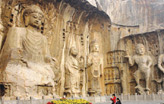Asia
Power lines up in progress at Japan nuke plant
Updated: 2011-03-22 20:53
(Agencies)
FUKUSHIMA, Japan - Workers reconnected power lines to all six reactor units at Japan's radiation-leaking nuclear plant Tuesday, its operator said, marking a significant step in bringing the overheated complex under control.
In making an announcement after days of anxious waiting by the public, Tokyo Electric Power Co. cautioned that much work needed to be done before the electricity can be turned on. Workers are checking all additional equipment for damage to make sure cooling systems can be safely operated, Tokyo Electric said.
In another advance, emergency crews dumped 18 tons of seawater into nearly boiling storage pool holding spent nuclear fuel, cooling it to 105 degrees Fahrenheit (50 degrees Celsius), Japan's nuclear safety agency said. Steam, possibly carrying radioactive elements, had been rising for two days from the reactor building, and the move lessens the chances that more radiation will seep into the air.
Added up, the power lines and concerted dousing bring authorities closer to ending a nuclear crisis that has complicated the government's response to the catastrophic earthquake and tsunami that devastated Japan's northeast coast 11 days ago.
Its power supply knocked out by the disasters, the Fukushima Dai-ichi nuclear complex has leaked radiation that has found its way into vegetables, raw milk, the water supply and even seawater across a band of Japan. The resulting fears of radiation mean the impact of the disasters has reverberated well beyond the disaster area and the families of the hundreds of thousands of displaced and of the estimated 18,000 dead.
"We must overcome this crisis that we have never experienced in the past, and it's time to make a nationwide effort," Chief Cabinet Secretary Yukio Edano, the government's public point-man, said earlier Tuesday in his latest remarks meant to soothe public anxieties.
In another repercussion, three of Japan's marquee companies _ Sony Corp., Toyota Motor Corp. and Honda Motor Co. _ announced temporary halts or extensions of shutdowns of production at plants in Japan. The reason is a shortage of parts _ a result of so many ruined factories in the disaster area.
The edginess was palpable in the town of Kawamata, just outside the city of Fukushima. Hundreds of people moved from their homes near the nuclear plant 50 miles (80 kilometers) away crowded into an elementary school gymnasium to hear about the impact of radiation on health from a doctor from Nagasaki, the city destroyed by an atomic bomb to end World War II.
"I want to tell you that you are safe. You don't need to worry. The levels of radiation here are clearly not high enough to cause damage to your health," Noboru Takamura told them. "Outside the 30-kilometer (19-mile) zone, there is no need to hang your laundry indoors or wear surgical masks _ unless you have hay fever."
Virtually everyone in the hall was wearing a mask.
Public sentiment is such in the area that Fukushima's governor rejected a request from the president of Tokyo Electric, or TEPCO, so he could apologize for the troubles.
"What is most important is for TEPCO to end the crisis with maximum effort. So I rejected the offer," Gov. Yuhei Sato said on national broadcaster NHK. "Considering the anxiety, anger and exasperation being felt by people in Fukushima, there is just no way for me to accept their apology."
While Fukushima's and many other schools, gymnasiums and other community buildings remain packed with displaced people, in the 11 days since the disasters the numbers of people staying in shelters has halved to 268,510, presumably as many move in with relatives.
In the first five days after the disasters struck, the Fukushima complex saw explosions and fires in four of the plant's six reactors, and the leaking of radioactive steam into the air. Since then, progress continued intermittently as efforts to splash seawater on the reactors and rewire the complex were disrupted by rises in radiation, elevated pressure in reactors and overheated storage pools.
Earlier Tuesday, the nuclear safety agency said Unit 2's storage pool was near boiling _ a condition if unabated could see the water boil away, exposing fuel rods that would throw up more radiation. At extremely high temperatures, the zirconium cladding around the rods could melt and explode.
The turnaround, in part, came as radiation levels abated from last week's highs, allowing authorities to bring in more workers. By Tuesday, 1,000 plant workers, subcontractors, defense troops and firefighters were at the scene, said Hidehiko Nishiyama, of the Nuclear and Industrial Safety Agency.
With the power lines connected, Tokyo Electric and experts said, however, days or even weeks would be needed to replace damaged equipment and vent any volatile gas to make sure electricity does not spark an explosion.
"You're going to get fires now as they energize equipment," said Arnold Gundersen, the chief engineer at the U.S.-based environmental consulting company Fairewinds Associates. "It's going to be a long slog."
Much of the broader public's concern has centered on radiation contamination of food and water. The government has already ordered a ban on spinach, canola and raw milk from the prefectures around Fukushima. The sea off the nuclear plant is showing elevated levels of radioactive iodine and cesium, prompting the government to test seafood.
Government officials and health experts say the doses are low and not a threat to human health unless the tainted products are consumed in abnormally excessive quantities.
The Vienna-based International Atomic Energy Agency said that radiation seeping into the environment is a concern and needs to be monitored. IAEA monitoring stations have detected radiation 1,600 times higher than normal levels _ but in an area about 12 miles (20 kilometers) from the power station, the limit of the evacuation area declared by the government last week.
Radiation at that level, while not high for a single burst, could harm health if sustained. If projected to last three days, radiation at those levels U.S. authorities would order an evacuation as a precaution.
The levels drop dramatically the farther you go from the nuclear complex. In Tokyo, about 140 miles (220 kilometers) south of the plant, levels in recent days have been higher than normal for the city but still only a third of the global average for naturally occurring background radiation.
E-paper

Rise and shine
The Chinese solar energy industry is heating up following recent setbacks in the nuclear sector
Bombs aim for regime change
CSI, with a twist
Literary path
Specials

Peony express
Growers of china's unofficial national flower are reaching out to europe for help

Tea-ing up
More turning to Chinese tea for investment opportunities like vintage wine

A cut above
The ancient city of Luoyang is home to a treasure trove of cultural wonders.
